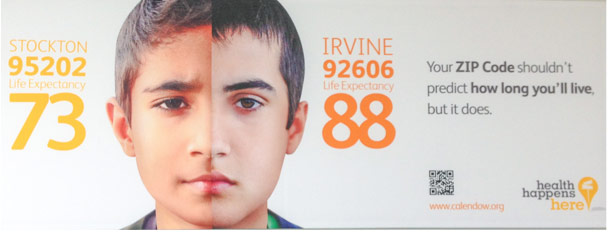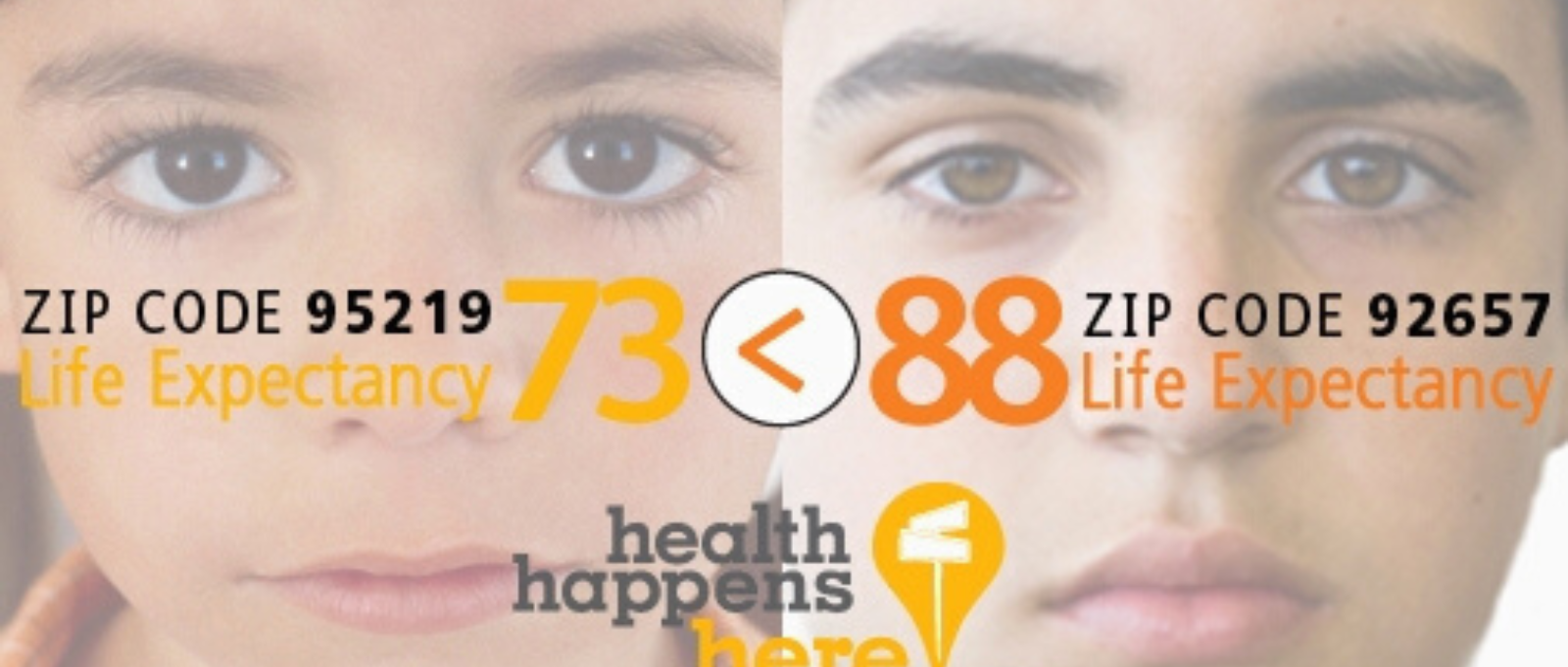March 30, 2015
Topic
“You are the sculptors, what will you make?”
Ron Sims
Former HUD Deputy Secretary and King County Executive, speaking on social equity at CivicWell’s 2015 Yosemite Conference
A recovering economy, shifting demographics and growing inequities are raising critical questions about how residents experience their communities – from interactions with police to affordable access of basic needs such as jobs, housing, healthy food, transportation, education and health care.
In the context of this article we will be discussing tools to prioritize limited local resources- from infrastructure investments to public services- to increase equitable distribution and better support for underserved and underrepresented neighborhoods.
The California Endowment highlighted these growing inequities in their “Portrait of California” report and a powerful companion series of “zip code” billboards like this that show how health outcomes are impacted by the community we live in. Local planners and policymakers – through the way they design communities – are sentencing people to dramatically different life outcomes.
As Ron Sims, former HUD deputy secretary and King County Executive (Seattle) challenged participants at our Yosemite conference last week – “you are the sculptors, what will you make?”

“Many local sustainability leaders are rethinking and redesigning their work – using a structural equity lens to analyze access and opportunity to the determinants of a healthy, prosperous life,” according to the 2014 “Equity in Sustainability” report of the Urban Sustainability Directors Network (USDN). “They are addressing distributional equity and uncovering the truths beneath community-wide data by identifying the groups who are the face of society’s disparities and targeting their resources accordingly.”
Instead of using the “peanut butter approach” of distributing a thin layer of services and infrastructure investments across the community, data-driven approaches can help target limited funds to areas with the highest need.
Moving from a Complaints-Based System
In 2009, after a series of shootings in Southeast Seattle – one of the city’s most diverse areas – that resulted in the deaths of five men of color, then-Mayor Greg Nickels took a tour of the neighborhood. In the area where the shootings were taking place, he found a streetlight out, and upon further investigation found that 80 streetlights were out.
As a basic safety measure, it concerned him that the lights weren’t getting fixed. Talking to staff, it was discovered that these lights weren’t getting fixed because no one had called to complain. This could be for a number of reasons (as described in the video below), but the bottom line was that the City could anticipate when the lights would need to be repaired based on when the light was installed and its life expectancy. Seattle moved to this approach – increasing safety and saving both money and staff time by making strategic change-outs instead of waiting to respond to one-off complaints.
Amazed at the simplicity and efficacy of this change, Mayor Nickels asked staff what other City systems were complaints-based. His staff’s reply – all of them!
From police and 911 emergency services to road repair, local governments rely on a complaints-based system that favors people who understand the system, trust local government will work for them, and speak English.
To address the systemic issues causing racial inequity, the City of Seattle started the Race and Social Justice Initiative and began using a Racial Equity Tool to improve public services and advance racial equity.
Former Seattle staffers Julie Nelson (now Director of Government Alliance on Race and Equity and a Senior Fellow at the Hass Institute for a Fair and Inclusive Society at UC Berkeley) and Glenn Harris (now President of the Center for Social Inclusion) shared lessons learned at our annual Yosemite conference. The video below from Gary Delgado and Backstory Narratives also provides an overview of the “Changing the Lights” story highlighted at the conference.
Portland’s budget-equity assessment tool
To address persistent concerns around high rates of disparity and income inequality, Portland conducted more than two years of research to assess the conditions of Portland’s diverse neighborhoods. In 2012, their findings culminated in the adoption of the Portland Plan, which today guides the city in setting and implementing policy. An important aspect of the Portland Plan is its explicit focus on equity – “Framework for Equity” – and includes tracking and sharing data on disparities.
The City make maps available online where community members can track public spending on services (including police and fire response times), infrastructure (transportation, housing, parks) and even compare how “complete” their community is in terms of assess to critical needs compared to other areas.

Review Portland’s other 2014-15 Budget Maps.
The Portland Plan also includes long-term policies like building an equity focus into the budget. All Portland city leaders working on the budget are expected to use the city’s budget equity assessment tool to determine how budget requests or decisions might benefit or burden communities of color.
Portland’s budget equity assessment tool is designed to:
- Promote an asset management approach to achieve equitable service across communities.
- Assess the equity and social impacts of budget requests to ensure that programs, projects and investments help to reduce disparities, improve participation and support leadership development.
- Track and report on service levels and investments by community and geography, including expanding the budget-mapping process.
“If you want to know a city’s priorities, look where it focuses its funding,” said Dante J. James, Director of the Office of Equity and Human Rights. “Tying equity to city bureaus’ budgets ensures that leaders are considering the impacts of their programs and policies on all Portlanders. It’s another positive step to institutionalizing this work within Portland city government.”
Closing the Equity Gap
Equity and sustainability go hand in hand and are essential pillars to community resiliency. Equity requires closing economic, educational and environmental gaps to provide equal access to opportunities- improving outcomes for all of our community members.
“Sustainability has the power to weave the strands that create hope and prosperity, health and wellness, community cohesion and true opportunity for all,” as highlighted in the USDN “Equity in Sustainability” report. “A focus on equity is an opportunity for sustainability leaders to address some of the thorniest, most deep-seated issues in society and to reinforce the inextricable ties that bind us in one shared destiny as people on the planet. Local governments have important roles to play, momentum on their side, and a window of opportunity within their grasp.”
The challenge elected officials face is to institutionalize equity principles and practices into procedures, and make it an intentional and integrated component of all of its decision-making processes – whether it’s decisions about where to locate affordable housing, expanding transportation, repairing roadways or changing light bulbs.
Stronger communities – and a healthier democracy – require that all residents share in the benefits of the community. New technologies and the racial equity tools highlights provide great resources to help achieve this vision, but we have to exercise the political muscle to make it happen.
Equity must be a priority – it is a necessary condition of a sustainable future.
This is the first of two articles on equity in planning. The second examines gentrification and strategies to reduce displacement.





